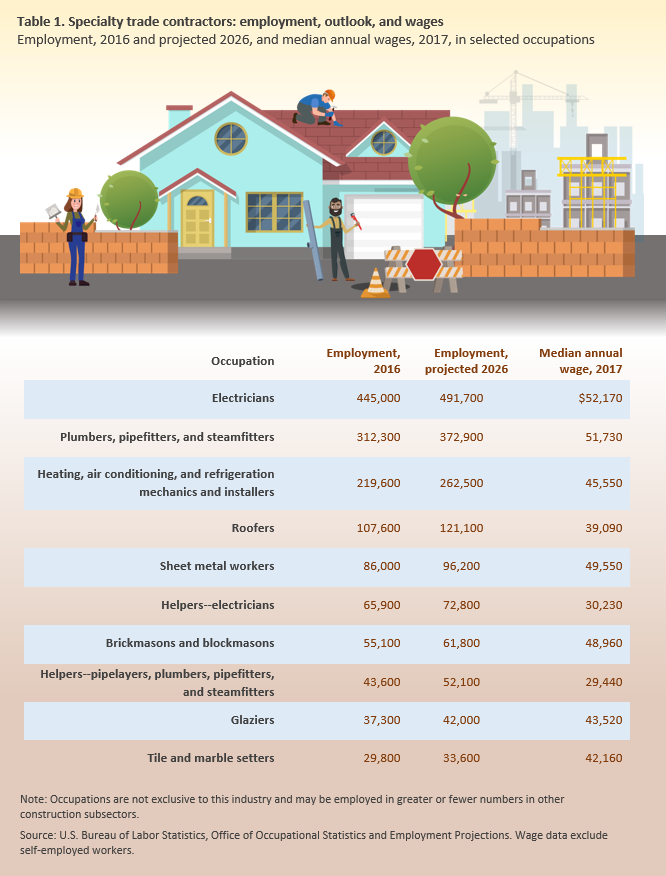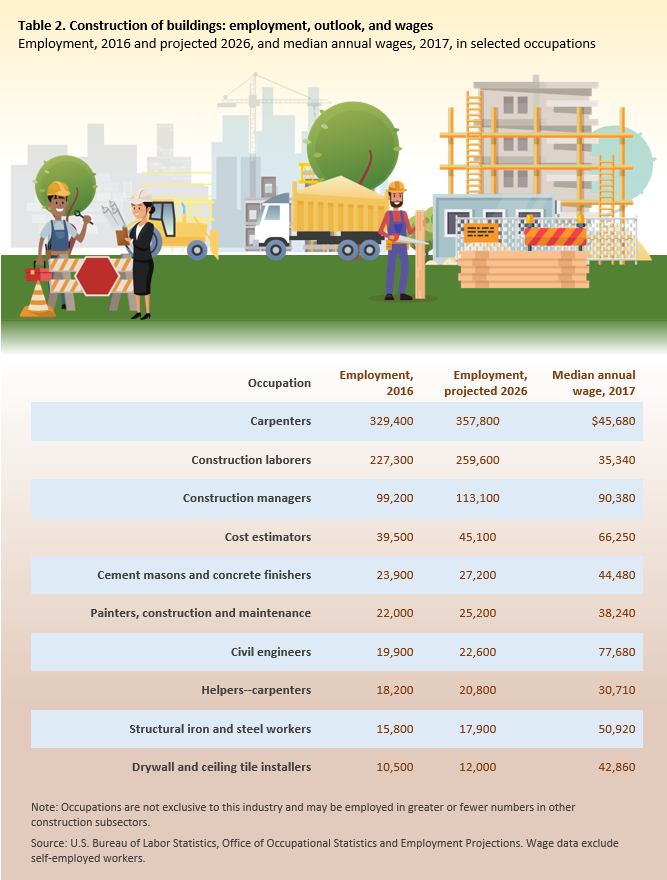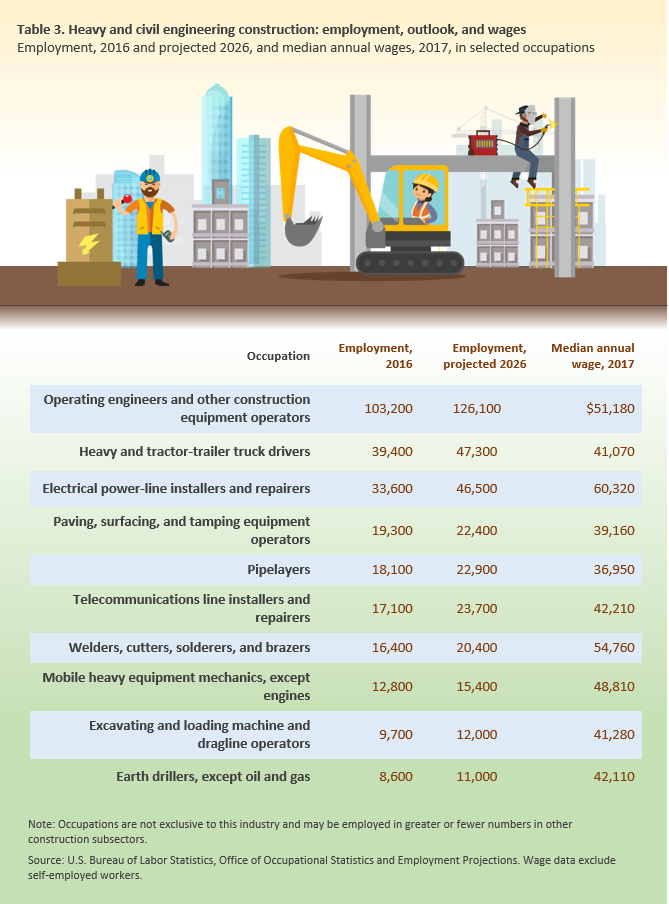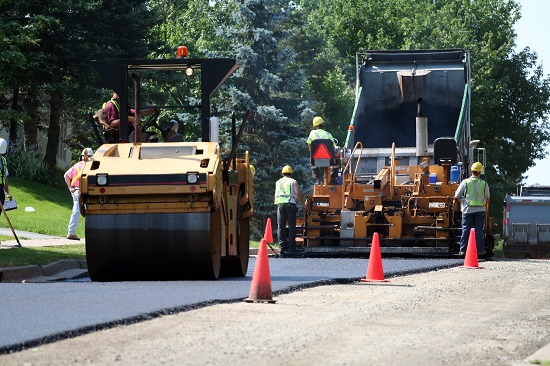Careers in construction: Building opportunity
Elka Torpey | August 2018
Perhaps you enjoy working with your hands on projects that will be around for years to come. Or maybe you’re looking for a job that pays well and has a promising future. These are among the many reasons to consider a career in construction.
In June 2018, there were 263,000 job openings in the construction industry, according to preliminary estimates from the U.S. Bureau of Labor Statistics (BLS). Through 2026, BLS projects faster-than-average employment growth in the industry. What’s more, its median annual wage of $45,820 in 2017 surpassed the $37,690 median wage for all industries.
And although some occupations in the construction industry typically require a college degree, you can enter many others with a high school diploma or less education. Read on to learn about construction careers.
Rebounding employment
Preliminary BLS data show that there were 7.2 million construction jobs in July 2018. That marks the highest employment level for the construction industry in a decade.
Leading into and through the Great Recession, the industry experienced declines in employment. In recent years, however, employment has trended upward. (See chart 1.)
Chart 1. Construction industry employment, January 1998–July 2018 (seasonally adjusted) and projected 2026
| Date |
Actual employment |
Projected employment |
|
Jan-98
|
5,983,000 |
|
|
Feb-98
|
5,997,000 |
|
|
Mar-98
|
5,969,000 |
|
|
Apr-98
|
6,049,000 |
|
|
May-98
|
6,087,000 |
|
|
Jun-98
|
6,130,000 |
|
|
Jul-98
|
6,172,000 |
|
|
Aug-98
|
6,215,000 |
|
|
Sep-98
|
6,225,000 |
|
|
Oct-98
|
6,262,000 |
|
|
Nov-98
|
6,301,000 |
|
|
Dec-98
|
6,378,000 |
|
|
Jan-99
|
6,357,000 |
|
|
Feb-99
|
6,429,000 |
|
|
Mar-99
|
6,402,000 |
|
|
Apr-99
|
6,480,000 |
|
|
May-99
|
6,516,000 |
|
|
Jun-99
|
6,547,000 |
|
|
Jul-99
|
6,571,000 |
|
|
Aug-99
|
6,586,000 |
|
|
Sep-99
|
6,613,000 |
|
|
Oct-99
|
6,640,000 |
|
|
Nov-99
|
6,687,000 |
|
|
Dec-99
|
6,709,000 |
|
|
Jan-00
|
6,752,000 |
|
|
Feb-00
|
6,730,000 |
|
|
Mar-00
|
6,811,000 |
|
|
Apr-00
|
6,794,000 |
|
|
May-00
|
6,770,000 |
|
|
Jun-00
|
6,778,000 |
|
|
Jul-00
|
6,794,000 |
|
|
Aug-00
|
6,796,000 |
|
|
Sep-00
|
6,807,000 |
|
|
Oct-00
|
6,814,000 |
|
|
Nov-00
|
6,817,000 |
|
|
Dec-00
|
6,792,000 |
|
|
Jan-01
|
6,824,000 |
|
|
Feb-01
|
6,841,000 |
|
|
Mar-01
|
6,862,000 |
|
|
Apr-01
|
6,844,000 |
|
|
May-01
|
6,849,000 |
|
|
Jun-01
|
6,840,000 |
|
|
Jul-01
|
6,845,000 |
|
|
Aug-01
|
6,827,000 |
|
|
Sep-01
|
6,813,000 |
|
|
Oct-01
|
6,804,000 |
|
|
Nov-01
|
6,784,000 |
|
|
Dec-01
|
6,785,000 |
|
|
Jan-02
|
6,775,000 |
|
|
Feb-02
|
6,766,000 |
|
|
Mar-02
|
6,755,000 |
|
|
Apr-02
|
6,710,000 |
|
|
May-02
|
6,684,000 |
|
|
Jun-02
|
6,701,000 |
|
|
Jul-02
|
6,688,000 |
|
|
Aug-02
|
6,701,000 |
|
|
Sep-02
|
6,702,000 |
|
|
Oct-02
|
6,689,000 |
|
|
Nov-02
|
6,713,000 |
|
|
Dec-02
|
6,700,000 |
|
|
Jan-03
|
6,704,000 |
|
|
Feb-03
|
6,667,000 |
|
|
Mar-03
|
6,654,000 |
|
|
Apr-03
|
6,689,000 |
|
|
May-03
|
6,706,000 |
|
|
Jun-03
|
6,723,000 |
|
|
Jul-03
|
6,735,000 |
|
|
Aug-03
|
6,760,000 |
|
|
Sep-03
|
6,783,000 |
|
|
Oct-03
|
6,784,000 |
|
|
Nov-03
|
6,796,000 |
|
|
Dec-03
|
6,827,000 |
|
|
Jan-04
|
6,848,000 |
|
|
Feb-04
|
6,838,000 |
|
|
Mar-04
|
6,887,000 |
|
|
Apr-04
|
6,901,000 |
|
|
May-04
|
6,948,000 |
|
|
Jun-04
|
6,962,000 |
|
|
Jul-04
|
6,977,000 |
|
|
Aug-04
|
7,003,000 |
|
|
Sep-04
|
7,029,000 |
|
|
Oct-04
|
7,077,000 |
|
|
Nov-04
|
7,091,000 |
|
|
Dec-04
|
7,117,000 |
|
|
Jan-05
|
7,095,000 |
|
|
Feb-05
|
7,153,000 |
|
|
Mar-05
|
7,181,000 |
|
|
Apr-05
|
7,266,000 |
|
|
May-05
|
7,294,000 |
|
|
Jun-05
|
7,333,000 |
|
|
Jul-05
|
7,353,000 |
|
|
Aug-05
|
7,394,000 |
|
|
Sep-05
|
7,415,000 |
|
|
Oct-05
|
7,460,000 |
|
|
Nov-05
|
7,524,000 |
|
|
Dec-05
|
7,533,000 |
|
|
Jan-06
|
7,601,000 |
|
|
Feb-06
|
7,664,000 |
|
|
Mar-06
|
7,689,000 |
|
|
Apr-06
|
7,726,000 |
|
|
May-06
|
7,713,000 |
|
|
Jun-06
|
7,699,000 |
|
|
Jul-06
|
7,712,000 |
|
|
Aug-06
|
7,720,000 |
|
|
Sep-06
|
7,718,000 |
|
|
Oct-06
|
7,682,000 |
|
|
Nov-06
|
7,666,000 |
|
|
Dec-06
|
7,685,000 |
|
|
Jan-07
|
7,725,000 |
|
|
Feb-07
|
7,626,000 |
|
|
Mar-07
|
7,706,000 |
|
|
Apr-07
|
7,686,000 |
|
|
May-07
|
7,673,000 |
|
|
Jun-07
|
7,687,000 |
|
|
Jul-07
|
7,660,000 |
|
|
Aug-07
|
7,610,000 |
|
|
Sep-07
|
7,577,000 |
|
|
Oct-07
|
7,565,000 |
|
|
Nov-07
|
7,523,000 |
|
|
Dec-07
|
7,490,000 |
|
|
Jan-08
|
7,476,000 |
|
|
Feb-08
|
7,453,000 |
|
|
Mar-08
|
7,406,000 |
|
|
Apr-08
|
7,327,000 |
|
|
May-08
|
7,274,000 |
|
|
Jun-08
|
7,213,000 |
|
|
Jul-08
|
7,160,000 |
|
|
Aug-08
|
7,114,000 |
|
|
Sep-08
|
7,044,000 |
|
|
Oct-08
|
6,967,000 |
|
|
Nov-08
|
6,813,000 |
|
|
Dec-08
|
6,701,000 |
|
|
Jan-09
|
6,567,000 |
|
|
Feb-09
|
6,446,000 |
|
|
Mar-09
|
6,291,000 |
|
|
Apr-09
|
6,154,000 |
|
|
May-09
|
6,100,000 |
|
|
Jun-09
|
6,010,000 |
|
|
Jul-09
|
5,932,000 |
|
|
Aug-09
|
5,855,000 |
|
|
Sep-09
|
5,787,000 |
|
|
Oct-09
|
5,716,000 |
|
|
Nov-09
|
5,696,000 |
|
|
Dec-09
|
5,654,000 |
|
|
Jan-10
|
5,580,000 |
|
|
Feb-10
|
5,500,000 |
|
|
Mar-10
|
5,537,000 |
|
|
Apr-10
|
5,553,000 |
|
|
May-10
|
5,520,000 |
|
|
Jun-10
|
5,516,000 |
|
|
Jul-10
|
5,508,000 |
|
|
Aug-10
|
5,524,000 |
|
|
Sep-10
|
5,501,000 |
|
|
Oct-10
|
5,508,000 |
|
|
Nov-10
|
5,506,000 |
|
|
Dec-10
|
5,467,000 |
|
|
Jan-11
|
5,427,000 |
|
|
Feb-11
|
5,451,000 |
|
|
Mar-11
|
5,477,000 |
|
|
Apr-11
|
5,485,000 |
|
|
May-11
|
5,516,000 |
|
|
Jun-11
|
5,528,000 |
|
|
Jul-11
|
5,547,000 |
|
|
Aug-11
|
5,552,000 |
|
|
Sep-11
|
5,584,000 |
|
|
Oct-11
|
5,588,000 |
|
|
Nov-11
|
5,593,000 |
|
|
Dec-11
|
5,611,000 |
|
|
Jan-12
|
5,626,000 |
|
|
Feb-12
|
5,629,000 |
|
|
Mar-12
|
5,625,000 |
|
|
Apr-12
|
5,618,000 |
|
|
May-12
|
5,604,000 |
|
|
Jun-12
|
5,621,000 |
|
|
Jul-12
|
5,632,000 |
|
|
Aug-12
|
5,648,000 |
|
|
Sep-12
|
5,661,000 |
|
|
Oct-12
|
5,674,000 |
|
|
Nov-12
|
5,684,000 |
|
|
Dec-12
|
5,724,000 |
|
|
Jan-13
|
5,746,000 |
|
|
Feb-13
|
5,784,000 |
|
|
Mar-13
|
5,802,000 |
|
|
Apr-13
|
5,796,000 |
|
|
May-13
|
5,829,000 |
|
|
Jun-13
|
5,855,000 |
|
|
Jul-13
|
5,859,000 |
|
|
Aug-13
|
5,878,000 |
|
|
Sep-13
|
5,910,000 |
|
|
Oct-13
|
5,931,000 |
|
|
Nov-13
|
5,963,000 |
|
|
Dec-13
|
5,932,000 |
|
|
Jan-14
|
5,981,000 |
|
|
Feb-14
|
6,007,000 |
|
|
Mar-14
|
6,041,000 |
|
|
Apr-14
|
6,081,000 |
|
|
May-14
|
6,111,000 |
|
|
Jun-14
|
6,131,000 |
|
|
Jul-14
|
6,174,000 |
|
|
Aug-14
|
6,204,000 |
|
|
Sep-14
|
6,236,000 |
|
|
Oct-14
|
6,254,000 |
|
|
Nov-14
|
6,270,000 |
|
|
Dec-14
|
6,295,000 |
|
|
Jan-15
|
6,332,000 |
|
|
Feb-15
|
6,356,000 |
|
|
Mar-15
|
6,340,000 |
|
|
Apr-15
|
6,390,000 |
|
|
May-15
|
6,428,000 |
|
|
Jun-15
|
6,444,000 |
|
|
Jul-15
|
6,466,000 |
|
|
Aug-15
|
6,485,000 |
|
|
Sep-15
|
6,498,000 |
|
|
Oct-15
|
6,540,000 |
|
|
Nov-15
|
6,592,000 |
|
|
Dec-15
|
6,632,000 |
|
|
Jan-16
|
6,636,000 |
|
|
Feb-16
|
6,649,000 |
|
|
Mar-16
|
6,690,000 |
|
|
Apr-16
|
6,699,000 |
|
|
May-16
|
6,693,000 |
|
|
Jun-16
|
6,698,000 |
|
|
Jul-16
|
6,728,000 |
|
|
Aug-16
|
6,731,000 |
|
|
Sep-16
|
6,763,000 |
|
|
Oct-16
|
6,787,000 |
|
|
Nov-16
|
6,811,000 |
|
|
Dec-16
|
6,822,000 |
|
|
Jan-17
|
6,873,000 |
|
|
Feb-17
|
6,919,000 |
|
|
Mar-17
|
6,922,000 |
|
|
Apr-17
|
6,917,000 |
|
|
May-17
|
6,924,000 |
|
|
Jun-17
|
6,940,000 |
|
|
Jul-17
|
6,934,000 |
|
|
Aug-17
|
6,962,000 |
|
|
Sep-17
|
6,971,000 |
|
|
Oct-17
|
6,988,000 |
|
|
Nov-17
|
7,030,000 |
|
|
Dec-17
|
7,072,000 |
|
|
Jan-18
|
7,100,000 |
|
|
Feb-18
|
7,167,000 |
|
|
Mar-18
|
7,164,000 |
|
|
Apr-18
|
7,180,000 |
|
|
May-18
|
7,210,000 |
|
|
Jun-18
|
7,223,000 (preliminary) |
|
|
Jul-18
|
7,242,000 (preliminary) |
|
|
Aug-18
|
|
- |
|
Sep-18
|
|
- |
|
Oct-18
|
|
- |
|
Nov-18
|
|
- |
|
Dec-18
|
|
- |
|
Jan-19
|
|
- |
|
Feb-19
|
|
- |
|
Mar-19
|
|
- |
|
Apr-19
|
|
- |
|
May-19
|
|
- |
|
Jun-19
|
|
- |
|
Jul-19
|
|
- |
|
Aug-19
|
|
- |
|
Sep-19
|
|
- |
|
Oct-19
|
|
- |
|
Nov-19
|
|
- |
|
Dec-19
|
|
- |
|
Jan-20
|
|
- |
|
Feb-20
|
|
- |
|
Mar-20
|
|
- |
|
Apr-20
|
|
- |
|
May-20
|
|
- |
|
Jun-20
|
|
- |
|
Jul-20
|
|
- |
|
Aug-20
|
|
- |
|
Sep-20
|
|
- |
|
Oct-20
|
|
- |
|
Nov-20
|
|
- |
|
Dec-20
|
|
- |
|
Jan-21
|
|
- |
|
Feb-21
|
|
- |
|
Mar-21
|
|
- |
|
Apr-21
|
|
- |
|
May-21
|
|
- |
|
Jun-21
|
|
- |
|
Jul-21
|
|
- |
|
Aug-21
|
|
- |
|
Sep-21
|
|
- |
|
Oct-21
|
|
- |
|
Nov-21
|
|
- |
|
Dec-21
|
|
- |
|
Jan-22
|
|
- |
|
Feb-22
|
|
- |
|
Mar-22
|
|
- |
|
Apr-22
|
|
- |
|
May-22
|
|
- |
|
Jun-22
|
|
- |
|
Jul-22
|
|
- |
|
Aug-22
|
|
- |
|
Sep-22
|
|
- |
|
Oct-22
|
|
- |
|
Nov-22
|
|
- |
|
Dec-22
|
|
- |
|
Jan-23
|
|
- |
|
Feb-23
|
|
- |
|
Mar-23
|
|
- |
|
Apr-23
|
|
- |
|
May-23
|
|
- |
|
Jun-23
|
|
- |
|
Jul-23
|
|
- |
|
Aug-23
|
|
- |
|
Sep-23
|
|
- |
|
Oct-23
|
|
- |
|
Nov-23
|
|
- |
|
Dec-23
|
|
- |
|
Jan-24
|
|
- |
|
Feb-24
|
|
- |
|
Mar-24
|
|
- |
|
Apr-24
|
|
- |
|
May-24
|
|
- |
|
Jun-24
|
|
- |
|
Jul-24
|
|
- |
|
Aug-24
|
|
- |
|
Sep-24
|
|
- |
|
Oct-24
|
|
- |
|
Nov-24
|
|
- |
|
Dec-24
|
|
- |
|
Jan-25
|
|
- |
|
Feb-25
|
|
- |
|
Mar-25
|
|
- |
|
Apr-25
|
|
- |
|
May-25
|
|
- |
|
Jun-25
|
|
- |
|
Jul-25
|
|
- |
|
Aug-25
|
|
- |
|
Sep-25
|
|
- |
|
Oct-25
|
|
- |
|
Nov-25
|
|
- |
|
Dec-25
|
|
- |
|
Jan-26
|
|
- |
|
Feb-26
|
|
- |
|
Mar-26
|
|
- |
|
Apr-26
|
|
- |
|
May-26
|
|
- |
|
Jun-26
|
|
- |
|
Jul-26
|
|
- |
|
Aug-26
|
|
- |
|
Sep-26
|
|
- |
|
Oct-26
|
|
- |
|
Nov-26
|
|
- |
|
Dec-26
|
|
7,575,700 |
BLS expects continued expansion of employment in the construction industry, with more than 7.5 million jobs projected by 2026 as population growth spurs demand for new buildings and infrastructure.
Occupations by subsector
The construction industry comprises three subsectors: specialty trade contractors, construction of buildings, and heavy and civil engineering construction. Employment in all of these subsectors is projected to grow over the 2016–26 decade, with more than half (485,600) of the new jobs overall expected in specialty trade contractors. Construction of buildings and heavy and civil engineering construction are projected to add 170,300 and 208,800 jobs, respectively. Wages vary by occupation.
The tables in this section show selected occupations in each of the construction subsectors. There is overlap among the occupations in each, so inclusion in one table doesn’t mean exclusion from another. For example, construction laborers work in all three subsectors.
Specialty trade contractors
Specialty trade contractors is the largest construction subsector, with employment projected to reach nearly 4.8 million by 2026. Workers in this subsector usually focus on a particular activity, such as plumbing or roofing. (See table 1.)

Table 1. Specialty trade contractors: employment, outlook, and wages
Employment, 2016 and projected 2026, and median annual wages, 2017, in selected occupations
| Occupation |
Employment, 2016 |
Employment, projected 2026 |
Median annual wage, 2017 |
|
Electricians
|
445,000 |
491,700 |
$52,170 |
|
Plumbers, pipefitters, and steamfitters
|
312,300 |
372,900 |
51,730 |
|
Heating, air conditioning, and refrigeration mechanics and installers
|
219,600 |
262,500 |
45,550 |
|
Roofers
|
107,600 |
121,100 |
39,090 |
|
Sheet metal workers
|
86,000 |
96,200 |
49,550 |
|
Helpers--electricians
|
65,900 |
72,800 |
30,230 |
|
Brickmasons and blockmasons
|
55,100 |
61,800 |
48,960 |
|
Helpers--pipelayers, plumbers, pipefitters, and steamfitters
|
43,600 |
52,100 |
29,440 |
|
Glaziers
|
37,300 |
42,000 |
43,520 |
|
Tile and marble setters
|
29,800 |
33,600 |
42,160 |
BLS projects rapid employment growth in specialty trade contractors for all of the occupations in the table. With nearly 20-percent increases in this subsector, employment of heating, air conditioning, and refrigeration mechanics and installers and helpers of pipelayers, plumbers, pipefitters, and steamfitters is projected to grow the fastest of these occupations. Electricians had the highest median annual wage, $52,170, in this subsector in 2017.
Construction of buildings
Employment in construction of buildings is projected to be about 1.7 million in 2026. This subsector includes general contractors and other establishments that have primary responsibility for an entire building or remodeling project. (See table 2.)

Table 2. Construction of buildings: employment, outlook, and wages
Employment, 2016 and projected 2026, and median annual wages, 2017, in selected occupations
| Occupation |
Employment, 2016 |
Employment, projected 2026 |
Median annual wage, 2017 |
|
Carpenters
|
329,400 |
357,800 |
$45,680 |
|
Construction laborers
|
227,300 |
259,600 |
35,340 |
|
Construction managers
|
99,200 |
113,100 |
90,380 |
|
Cost estimators
|
39,500 |
45,100 |
66,250 |
|
Cement masons and concrete finishers
|
23,900 |
27,200 |
44,480 |
|
Painters, construction and maintenance
|
22,000 |
25,200 |
38,240 |
|
Civil engineers
|
19,900 |
22,600 |
77,680 |
|
Helpers--carpenters
|
18,200 |
20,800 |
30,710 |
|
Structural iron and steel workers
|
15,800 |
17,900 |
50,920 |
|
Drywall and ceiling tile installers
|
10,500 |
12,000 |
42,860 |
Table 2. Construction of buildings: employment, outlook, and wages
Employment, 2016 and projected 2026, and median annual wages, 2017, in selected occupations
| Occupation |
Employment, 2016 |
Employment, projected 2026 |
Median annual wage, 2017 |
|
Carpenters
|
329,400 |
357,800 |
$45,680 |
|
Construction laborers
|
227,300 |
259,600 |
35,340 |
|
Construction managers
|
99,200 |
113,100 |
90,380 |
|
Cost estimators
|
39,500 |
45,100 |
66,250 |
|
Cement masons and concrete finishers
|
23,900 |
27,200 |
44,480 |
|
Painters, construction and maintenance
|
22,000 |
25,200 |
38,240 |
|
Civil engineers
|
19,900 |
22,600 |
77,680 |
|
Helpers--carpenters
|
18,200 |
20,800 |
30,710 |
|
Structural iron and steel workers
|
15,800 |
17,900 |
50,920 |
|
Drywall and ceiling tile installers
|
10,500 |
12,000 |
42,860 |
All but one of the occupations in table 2 (carpenters) are projected to have faster-than-average employment growth in this subsector from 2016 to 2026. Employment in each of the other occupations in the table is projected to grow by about 14 percent in this subsector. Construction managers had the highest pay of the occupations in table 2, with a median annual wage of $90,380 in construction of buildings in 2017.
Heavy and civil engineering construction
Heavy and civil engineering construction focuses on highway, utility, and other infrastructure projects; employment in this subsector is projected to be almost 1.2 million in 2026. Table 3 shows some of the occupations involved in this work.

Table 3. Heavy and civil engineering construction: employment, outlook, and wages
Employment, 2016 and projected 2026, and median annual wages, 2017, in selected occupations
| Occupation |
Employment, 2016 |
Employment, projected 2026 |
Median annual wage, 2017 |
|
Operating engineers and other construction equipment operators
|
103,200 |
126,100 |
$51,180 |
|
Heavy and tractor-trailer truck drivers
|
39,400 |
47,300 |
41,070 |
|
Electrical power-line installers and repairers
|
33,600 |
46,500 |
60,320 |
|
Paving, surfacing, and tamping equipment operators
|
19,300 |
22,400 |
39,160 |
|
Pipelayers
|
18,100 |
22,900 |
36,950 |
|
Telecommunications line installers and repairers
|
17,100 |
23,700 |
42,210 |
|
Welders, cutters, solderers, and brazers
|
16,400 |
20,400 |
54,760 |
|
Mobile heavy equipment mechanics, except engines
|
12,800 |
15,400 |
48,810 |
|
Excavating and loading machine and dragline operators
|
9,700 |
12,000 |
41,280 |
|
Earth drillers, except oil and gas
|
8,600 |
11,000 |
42,110 |
BLS projects much-faster-than-average employment growth in heavy and civil engineering construction over the 2016−26 decade for the occupations shown in table 3. Employment growth of electrical power-line installers and repairers is expected to be the fastest, with a projected increase of nearly 39 percent in heavy and civil engineering construction. These installers and repairers also had the highest median annual wage, $60,320, of occupations shown in the table.
Paving the way to a career
Most construction careers require specific skills and aptitudes, such as dexterity, physical stamina, and problem-solving ability. Construction workers learn many of the skills they need on the job. In fact, all but one of the occupations shown in the tables typically require on-the-job training for workers to become competent.
Apprenticeships are common in some occupations, such as sheet metal workers and plumbers. In other occupations, new workers may get informal on-the-job training, including instruction from those who have experience.
Whether you have little formal education or you aspire to earn a college degree, you can choose from a number of occupations in construction. For example, occupations such as roofers and carpenters’ helpers typically require no formal educational credential at the entry level. And you can typically enter more than half of the occupations shown in the tables with a high school diploma or its equivalent, such as a GED.
You typically need a certificate or other postsecondary nondegree award to enter the occupations of heavy and tractor trailer truck drivers and heating, air conditioning, and refrigeration mechanics and installers. The three highest paying occupations in the tables—construction managers, cost estimators, and civil engineers—typically require a bachelor’s degree for entry.
Find detailed information about entry requirements, job outlook, and more for these occupations—and hundreds of others—in the Occupational Outlook Handbook. Data on the physical, mental, and cognitive demands; environmental conditions; and vocational-preparation requirements in these occupations are available from the Occupational Requirements Survey.
Elka Torpey is an economist in the Office of Occupational Statistics and Employment Projections, BLS. She can be reached at torpey.elka@bls.gov.
Suggested citation:
Elka Torpey, "Careers in construction: Building opportunity,"
Career Outlook,
U.S. Bureau of Labor Statistics,
August 2018.
 United States Department of Labor
United States Department of Labor
